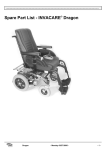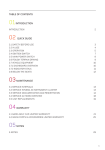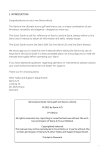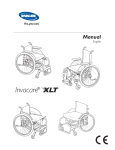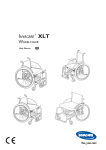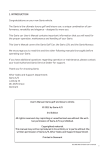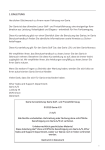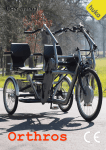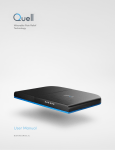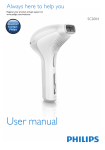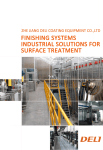Download User manual
Transcript
Qimova Chair Manual driven User manual Version 1.11 | Feb 2014 User manual | Qimova chair Qimova a/s All rights reserved. The information provided herein may not be reproduced and/or published in any form without the prior written authorization of Qimova a/s. This information is valid for the Qimova wheelchair in its standard version. Due to continuous development and improvements Qimova a/s reserves the right to changes and modifications. Qimova a/s cannot be held liable for possible errors in the information or the consequences hereof. Qimova a/s does not accept any liability for loss resulting from work made by third parties. Page 2 of 43 | Version 1.11 Qimova chair | User manual Table of contents 1 2 3 4 5 6 7 Introduction............................................................................................... 5 1.1 General information ..................................................................................................... 5 1.2 Definitions.................................................................................................................... 5 1.3 Service and technical support ...................................................................................... 5 1.4 Declaration of Conformity ...........................................................................................6 1.5 Approvals .....................................................................................................................6 1.6 Warranty ...................................................................................................................... 7 1.7 Liability ........................................................................................................................8 1.8 Safety and misuse warnings ........................................................................................9 General description ................................................................................. 10 2.1 Qimova design ........................................................................................................... 10 2.1.1 The Qimova chair concept ................................................................................... 10 2.1.2 The seating system .............................................................................................. 10 2.2 Overview manual wheelchair .....................................................................................11 Basic features ..................................................................................................................... 12 2.3 Alternative features ................................................................................................... 12 The control system ................................................................................... 13 Operating instructions ............................................................................. 16 4.1 Seating system ........................................................................................................... 16 4.2 Anti-tip/step tube ...................................................................................................... 16 4.3 Seating system ........................................................................................................... 17 4.3.1 Backrest adjustment ........................................................................................... 17 4.3.2 Seat adjustment .................................................................................................. 19 4.4 Armrests ................................................................................................................... 20 4.5 Leg rests ..................................................................................................................... 21 4.5.1 Elevating leg rests ............................................................................................... 21 Elevating manually operated leg rest ............................................................................. 21 Elevating electrically operated leg rest ..........................................................................22 4.5.2 Folding up the footplates ....................................................................................22 4.5.3 Turning the leg rests to one side ........................................................................23 4.5.4 Removing/attaching the leg rests.......................................................................24 Adjustment of the chair............................................................................ 25 5.1 Height adjustment ..................................................................................................... 25 5.2 Centre of gravity ........................................................................................................ 25 5.3 Seat depth .................................................................................................................. 25 5.4 Seat width .................................................................................................................. 25 5.5 Leg rests .....................................................................................................................26 5.6 Armrests .................................................................................................................... 27 5.7 Brakes ....................................................................................................................... 28 5.8 Tools for adjustment and replacement .................................................................... 30 Transfer of user ....................................................................................... 31 6.1 Transferring the user manually ................................................................................. 31 6.2 Transferring the user using an aid ............................................................................32 Passing obstacles ..................................................................................... 33 7.1 Kerbs .......................................................................................................................... 33 7.2 Ramps ........................................................................................................................ 33 7.3 Steps and steep terrain .............................................................................................. 33 Version 1.11 | Page 3 af 43 User manual | Qimova chair 8 Accessories ............................................................................................. 34 8.1 Headrest .................................................................................................................... 34 8.1.1 Headrest adjustment .......................................................................................... 34 9 Safety during transit................................................................................ 35 9.1 Belt restraints ............................................................................................................ 36 9.2 Vehicle clamping system .......................................................................................... 37 9.3 Packing for shipment or storage ............................................................................... 38 10 Cleaning and maintenance ..................................................................... 39 10.1 Protective cover/incontinence cover ....................................................................... 39 10.2 Washing instructions for upholstery ...................................................................... 39 10.3 Maintaining the wheels ........................................................................................... 39 10.4 Disposal ................................................................................................................... 40 11 Technical Data........................................................................................ 41 11.1 Identification .............................................................................................................41 11.2 Standards ..................................................................................................................41 11.3 Disclosure information (ISO) .................................................................................. 42 11.4 Electrical installation ............................................................................................... 42 12 About Qimova ........................................................................................ 43 Page 4 of 43 | Version 1.11 Qimova chair | User manual 1 Introduction 1.1 General information Congratulations on the purchase of your new Qimova chair. We hope it makes your daily life easier and more comfortable for many years to come. Qimova chairs are bespoke wheelchairs developed using a unique modular system. This enables a precision fit for the user that is also easy to operate. This manual has been written to explain the many features and benefits to users and caregivers and to help you get the most out of your chair. As well as detailed descriptions of a number of the chair’s functions, this manual also provides hints on the best way to use the chair and advice on cleaning and maintenance. Should you have any other questions concerning the chair, extra equipment or individual adjustment, you are always welcome to contact your local dealer or visit our website www.qimova.com. 1.2 Definitions In this manual the following terms and definitions are used: Product: Manual or electric wheelchair manufactured and delivered by Qimova. Customer: The person who directly obtains a product from Qimova. Dealer: The person who delivers a product obtained from Qimova to customers or third parties. User: The person who uses a product manufactured by Qimova. 1.3 Service and technical support For information about specific mechanical adjustments and settings, programming of the control system, maintenance, spare parts or repair work, please contact your local dealer. When contacting your dealer please supply the information from the identification label of the product. Version 1.11 | Page 5 af 43 User manual | Qimova chair Identification label On all variants of the Qimova Wheelchair the identification label is positioned on the horizontal crossbar of the frame underneath the seating system. The label is positioned on the side facing the castors. Identification label A. B. C. D. E. Model Production year Serial number, identification Use area / Type class Maximum user load Figure 1 Your authorised local dealer is trained to carry out any necessary maintenance. The spare parts list with the matching item numbers and drawings is available at your local dealer. You can also find the information on the website www.qimova.com. 1.4 Declaration of Conformity Qimova a/s as manufacturer with sole responsibility declares that the wheelchair conforms to the requirements of the European Directive for Medical Products 93/42/EEC. The CE marking is placed on the identification label (Figure 1 above). 1.5 Approvals Development, construction and design of this product fully meet the requirements regarding technical safety laid down on the following standards: Page 6 of 43 | Version 1.11 Qimova chair | User manual Application EN 12182: 2002 Power and manual wheelchairs Technical aids for disabled persons “General Requirements and Test Methods” EN 12183: 2002 Manual wheelchairs Manually propelled wheelchairs “Requirements and Methods of Testing” ISO 7176-8 Power and manual wheelchairs Requirements and test method for static, impact and fatigue strength ISO 7176-16 Power and manual wheelchairs Requirements of resistance to fire. ISO 7176-19: 2008 Power and manual wheelchairs Crash test Wheeled mobility devices for use in motor vehicles EN 12184: 2002 Power and manual wheelchairs EMC (Electro Magnetic Compatibility). (Chairs with electrically operated tilt/recline/leg rests only). 1.6 Warranty Irrespective of what is determined concerning warranty conditions applicable to the Product, in all cases the following applies with regard to the warranty: 1. Except insofar as described otherwise Qimova guarantees the Product for its suitability for the purpose for which the Product is intended - all of these points as described in this manual - and for the quality of the material of which the Product is made and the manner in which the Product is manufactured. 2. Repairs or replacement of parts of the Product that may be necessary as a result of faults that are based on qualitatively faulty material or manufacturing errors will be executed free of charge, as long as such faults occurred within one (1) year after the date of delivery of the Product to the Customer. The parts to be replaced must be shipped postage-paid to Qimova. Disassembly or assembly of these parts is at the expense of the Customer. Therefore the following cases are not eligible for free repair or replacement as described above: Repair or replacement that is necessary in connection with faults that arise one (1) year after the date of delivery of the Product to the Customer; Repair or replacement that is required in connection with faults due to improper or careless use of the Product or that are based on the Product being used for another purpose than the one for which it is intended, in which regard it applies that if the Customer is a Dealer, this Dealer will indemnify Qimova against possible claims from Users or other third parties for faults based on an incorrect or careless use of the Product; Version 1.11 | Page 7 af 43 User manual | Qimova chair Parts that are subject to wear and the need for repair, or replacement of the parts as the actual consequence of normal wear. Irrespective of what is stipulated under 2, it applies as far as an electric Product is concerned that with regard to the battery that forms part of the Product warranty, it is only given in cases of faults or non-functioning of the battery that are demonstrably the direct consequence of material or manufacturing errors. A fault or non-functioning of the battery as a result of normal wear is not covered by the warranty as meant in these warranty stipulations. Similarly not covered by the warranty are faults or non-functioning that are the consequence of improper or unprofessional use of the Product or the battery that is part of the Product, including the incorrect charging of the battery and the failure to carry out timely and good maintenance, in which context it also applies that if the Customer is a Dealer, this Dealer will indemnify Qimova against possible claims from Users or other third parties that are based on the above mentioned improper or unprofessional use of the Product or the battery that is part of the Product. The warranty conditions as mentioned in the above stipulations become null and void in all cases if: The guidelines from Qimova for the maintenance of the Product are not, or insufficiently, followed; A necessary repair or replacement of parts is based on neglect, damage or abuse of the Product or a use of the Product for another purpose than the one for which it was intended; Parts of the Product are replaced by parts of another origin than those which Qimova uses and/or parts of the Product are replaced without the permission of Qimova. The warranties as mentioned in stipulations 1 through 3 also become null and void if what is involved is re-used by a new user within the warranty period and that such re-use necessitates adaptations to the product and those adaptations are carried out without the instructions and/or at the order of Qimova. To retain rights under the above delineated warranties the Customer must, in case of damage or other calamities, as soon as possible contact Qimova and inform them as fully as possible. The possibility of taking recourse to the above-mentioned warranty conditions becomes null and void for the Customer in any case after 20 workdays after the claim situation or the calamity arises that was the reason for the recourse to the guarantee. The replacement of a part or the repair or the reconditioning of the Product within a current warranty period does not extend the warranty period. Qimova gives no warranty on repairs to or reconditioning of the Product carried out other than under order of and/or at the instructions of Qimova. If repairs and/or reconditioning are executed by or on behalf of a Customer, the Customer indemnifies Qimova with respect to the claims of third parties who result, in the broadest sense of the word, from such repairs or reconditioning. 3. 4. 5. 6. 7. 8. 1.7 Liability Irrespective of what is determined regarding liability in the general conditions applicable to the Product, with regard to liability in any case the following applies: Page 8 of 43 | Version 1.11 Qimova chair | User manual 1. Qimova shall only be liable for direct damage on goods or for death and personal injury to any person caused by a defect in Qimova’s Products, to the extent such liability arises as a result of mandatory statutory provisions on product liability. 2. Qimova shall in no event be liable for any indirect, punitive or consequential damage, including but not limited to lost profits and damages resulting from loss of the use of the Product arising out of or connected with the use of the Product. Defects mean design defects, manufacturing defects, and defects in marketing. 1.8 Safety and misuse warnings Qimova a/s accepts no liability whatsoever for damage or injury caused by the failure to adhere to the safety guidelines and instructions or due to carelessness in using and cleaning the Product. Modifications to the wheelchair or any part of it are not covered by the warranty and are therefore not recommended. Signs, symbols and instructions on the wheelchair comprise part of its safety facilities. They must never be covered or removed and must be legible throughout the lifespan of the wheelchair. Although the wheelchair has been tested according to the EMC requirements it is recommended that the electric wheelchair is switched off when mobile phones are used in vicinity of an electric wheelchair with special electronic adaptations. To avoid potentially dangerous situations such as tipping, it is necessary that you become familiar with your new wheelchair on level ground first. Check the equipment to make sure that it functions as it should according to the instructions described herein. Otherwise, you may subject the equipment, yourself or others to injury or damage. Do not try to operate the equipment if any mechanical or electrical part is broken or behaves erratically in any way. Be careful not to get loose clothing, blankets etc. into the wheels or other moveable parts. Be careful not to get your fingers or other parts of the body trapped in the moveable parts. Report any malfunctions immediately to your local dealer. Bring seating to upright position before any steep inclines. The anti-tip must always point downwards when the chair is in use. When getting into or out of the wheelchair, the wheelchair control must be switched off. Do not use the footplates as a step when getting into or out of your wheelchair. Version 1.11 | Page 9 af 43 User manual | Qimova chair 2 General description 2.1 Qimova design The Qimova chair is a modern, Danish designed and produced wheelchair of extraordinarily high quality, which is available in many different models and configurations. The basic idea behind the development of the Qimova chair is to use a modular system to create attractive bespoke wheelchairs that combine outstanding seating and posture support for individual. The modular design of the Qimova chair with its variable functionality is well suited to changing user needs as well as to recirculation. 2.1.1 The Qimova chair concept A Qimova chair offers a good seating position with posture control, pressure distribution and relief. The chair has a range of features that enable the user to change sitting position and weight distribution. The tilt-in-space, full backrest recline, elevating and length-compensating leg rests make it possible to relax in the chair in many different positions. The chair also offers a wide range of options to adjust dimensions to meet the individual needs. The Qimova chair is also designed to accommodate special adaptations. Qimova has extensive experience with making special designs of frames and cushions, for example: wide seating, padding, side in fills, and individually built seats and backrest. 2.1.2 The seating system The Qimova chair offers an excellent seating system, which enables the user to stay in the chair for as many hours as needed. The Qimova Pressure Relief Cushion absorbs the pressure on the coccyx and vertebral column in centrally placed soft foam. Surrounding high elastic cold foam supports the remaining weight of the body. This construction prevents the pelvis from sliding forward and ensures an anatomically correct sitting position. The air channels in the soft foam aid ventilation and prevent the build-up of heat and humidity. The seat comes in different sizes (seat width and seat depths) and has room for adjustment to make it fit the individual user. The backrest is also made of cold foam. Side supports, wedges, are built in. The back comes in three different heights: small, medium and large. The width corresponds to the width of the seat, but the position of the wedges can be configured to meet special requirements. Page 10 of 43 | Version 1.11 Qimova chair | User manual 2.2 Overview manual wheelchair 1: 2: 3: 4: 5: 6: 7: 8: 9: 10: 11: 12: 13: Backrest Armrest Seat Leg rest Headrest Remote control Front castor Vehicle clamping system Footplate Pushing handle Lumbar support pump Brakes 13 13: 14: 15: 16: Anti-tip knob Control box with battery Vehicle clamping system Anti-tip device Charger 14 13 15 16 Figure 2 Version 1.11 | Page 11 af 43 User manual | Qimova chair Basic features Versatile seating system Adjustable lumbar support Adjustable height, angle and length of armrests Adjustable seat height Adjustable seat depth Adjustable seat width Height adjustable pushing handle Adjustable centre of gravity Full backrest recline to horizontal position Adjustable calf supports in height, angle and depth Detachable seat and backrest covers Wide 16” puncture proof wheels 8” front castors Two combined anti-tip and step tubesdevices Wireless or wired remote control (chairs with electrically operated tilt/recline/leg rests only) Fortified vehicle clamping system 2.3 Alternative features Air-inflatable tyres 12”, 20” or 24” wheels combined with 6” or 8” front castors Front wheel drive Drum brakes Angle, height, forward and backward adjustable head rest Multi arm headrest frames Thoracic and/or side supports Adjustable pommel Rotating and foldable pushing handle Choice of colour of fabric: Grey, Black, Red, Orange, Green, blue Choice of other kinds of fabric e.g. incontinence lining Pelvic belt or body harness Page 12 of 43 | Version 1.11 Qimova chair | User manual 3 The control system Concens C3-controller Introduction The electric actuators for tilt, recline and leg rests on electrically operated chairs are managed by a C3-controller. The controller can recognize and be used with up to 10 remotes. Each remote has a unique ID-number, so each C3-controller can have its own remote without disturbing other controllers in the same room - see note 1. Inserting and ejecting the battery The C3-controller uses a compact environmentally-friendly NiMH battery, which is fixed in the C3-housing by strong magnets. Before inserting the battery, clean the magnetic poles for dirt. Insert the battery in the housing and turn the battery to align the dots of the housing and battery. To eject the battery, turn 90 degrees to the right or to the left. Charging the battery The battery has to be charged in the supplied C3-charger. A full charge takes normally about 5-8 hours, depending on state of charge. A NiMH battery can be charged although it has not fully discharged without decreasing the lifetime. When connecting the C3-charger to the mains, the yellow diode lights up continuously and there is typically a single flash in the green diode before it turns off again. By inserting the battery, the green diode flashes once each second while charging the battery. After finishing charging, the green diode stops flashing and lights up continuously, the battery can now be removed and is ready for use. Start-up of controller Push in the battery (2) in the C3-housing (4) and turn the battery to align the 2 dots. On correct installation of the battery you will hear a buzzer-sound for about 5 seconds while the C3-controller initializes. Thereafter C3 is ready for operating. Occasionally there will be sounds after the initializing. 2 long sounds - Battery power level is too low. Battery has to be charged. 5 short sounds - It’s not possible to run the C3 controller due to lack of power. Start-up is not possible before the battery has been recharged. Version 1.11 | Page 13 af 43 User manual | Qimova chair Figure 3 Enable and disable use of remotes Hold magnet-side at remote top end up against the C3-controller (4) directly where the little round indentation in the plastic is, just next to the battery (2) as shown in Figure 3. Enable use of a remote Start-up controller and hold remote (1) close to C3 (4) as shown on the Figure 3. Press on a random button for about 3 seconds to enable a remote (1) for use. C3-controller (4) returns with 1 short sound. Disable use of all remotes Place remote (1) as shown on the Figure 3, press on a random button for about 15 seconds (after 3 seconds a short sound is emitted but continue to push the button). The C3controller returns with 2 short sounds. Use of the remote again requires that you proceed with a new enable remote procedure. It is possible to store up to a maximum of 10 different remotes in a C3-controller. When enabling the 10th remote, the C3-controller will emit 1 long sound. C3-controller alarm types 1) The battery needs to be charged if the C3-controller gives 5 short sounds immediately after the buzzer sound is finished when a battery is connected to the C3-controller. It is not possible to run actuators. 2) If the battery voltage level goes below the minimum allowed value while running, the C3-controller emits 3 short sounds. Then it is only possible to run the actuators in a customer predefined backwards direction, before the battery needs to be removed for charging. 3) If the battery reaches the absolute minimum allowed voltage level during run, the C3controller emits only 1 short sound, all actuators stops momentarily and the C3-controller disconnects itself to save power and protect the battery from permanent damage. The Page 14 of 43 | Version 1.11 Qimova chair | User manual battery has to be charged. If you choose to use a new fully charged battery instead, you must wait at least 1 minute after removing the battery before you connect the other charged battery to the C3-controller. The alarm will not sound in stand-by mode, even though the battery needs recharging. It is recommended to always have a well-charged battery ready in your C3-controller to avoid functional troubles when most needed in your application. Heavy loads on a battery Repeated runs at a high rate with heavy loads can cause heating up inside the battery. If this happens a temperature sensor will disconnect the power until the allowed working temperature is established once again - see note 3. Advice about charging In areas with a heavy use of radio communication in the 2.4GHz-frequency band, there is a risk that you need to charge the battery once a day or once every second day even without using the C3-controller at all. Under such circumstances – the C3-controller automatically powers off from the connected battery if the measured voltage value reaches a critically low “battery damaging” level. When replacing a discharged battery you should wait at least 1 minute before connecting a new fully charged battery. A NiMH-battery can be recharged even though it is not completely discharged as this will have no effect on its overall lifetime. Warning! If the C3-controller for some reason is not going to be used for a few days remove the battery from the C3-controller to protect the battery against complete discharge and permanent damage. C3-controller, note 1 The wireless remote controller system transmits/receives using the 2.4GHz frequency band, which is a free open band, used by many other applications. If any of these applications are used nearby, occasional stops in a C3-controller can occur while this equipment is used. It is possible to get remotes with less transmit power (less disturbing distance) for use in areas where more than one C3-controller system is used. It is not possible for other applications – or other disabled remotes - to start actuators on a C3controller. C3-controller, note 2 The battery is pulled-into the C3-housing by heavy magnets. Take care with dirt, such as metallic particles and other small magnetic parts. This can make electrical contact impossible and incapacitate the C3-controller / C3-charger to such an extent that it has to be sent for repairs. Always check for dirt on the poles of the battery before inserting into the C3-controller. C3-controller, note 3 A warm battery, where the temperature sensor has disconnected from the power mains, has to cool down again for at least half an hour before it is stable for normal use again. Version 1.11 | Page 15 af 43 User manual | Qimova chair 4 Operating instructions 4.1 Seating system The chair can be used as an alternative to a bed in cases where the user wants to rest thereby avoiding moving the user. Always ensure that the anti-tip devices are mounted correctly on the chair. The chair is normally stable with the user in position even when the backrest is reclined to horizontal position. However, certain sudden movements by the user or other people can cause the chair to tip. Therefore, we strongly recommend that the anti-tip devices be used at all times. After checking that the anti-tip devices are in the correct, downward facing position as close to the floor as possible, these three procedures should be followed: Tilt the seat to the backmost position using the tilting handle, located on the right side of the pushing handle on chairs with gas spring operated tilt and recline or the remote-control on chairs with electrically operated tilt and recline. This is the primary way to change the sitting position Elevate the leg rests to the desired position Lower the backrest to the desired position using the handle placed on the left side of the pushing handle or the remote control. Typically, it will only be necessary to change the angle between the seat and the backrest when preparing the chair for a position of rest. In some cases, the resting position can be enhanced by adjusting the lumbar support. This is done using the pump placed on the right hand side of the lower part of the backrest. To expel air from the lumbar support, use the little black button on the pump. Going from a position of rest and back to normal sitting position cannot be done by reversing the 3 points above, but as follows: Tilt the seat forward to horizontal position Manoeuvre the backrest up to normal position. Return the leg rests to normal position and ensure they are not in the way of the front castors. If the lumbar support has been changed, return it to normal position using the rubber hand pump. Readjust the anti-tip devices so that they are still facing the floor but in a higher position. This ensures that the chair can overcome small obstacles like doorways. 4.2 Anti-tip/step tube A combined anti-tip and step tube is located at the rear end of the bottom frame. The device is operated by a small knob placed on top of the vehicle clamping system. Page 16 of 43 | Version 1.11 Qimova chair | User manual Pull the knob and adjust the anti-tip devices in length, rotate them or remove them. The anti-tip devices are dented in a way that makes it easy to make adjustments. After placing the device in the desired position, simply slip the knob in place. It is highly recommended that you use the chair permanently fitted with the anti-tip/step tube device, as it will prevent the chair from tipping backwards in extreme positions. Situations will however arise, where it may be necessary to remove or position them in an upright state. In such cases, it is strongly recommended that an attendant is present at all times. 4.3 Seating system Both the seat and the backrest are built on firm steel frames, which give a strong and stable construction to the chair. Apart from the standard seat and backrest sizes, the position of the seat on the seat frame can be adjusted see section 5.3 The upholstery is moulded in cold foam. The side supports in the back as well as in the seat compensate for different seat widths. In most cases, the side wedges in the backrest can serve as side supports. The cold foam is designed to keep its form for many years. Upholstery is 88% polyester and 12% polyurethane. 4.3.1 Backrest adjustment The following section covers how to adjust the backrest. Version 1.11 | Page 17 af 43 User manual | Qimova chair Chairs with electrically operated tilt, recline and/or leg rests The angle between the backrest and the seat can be adjusted by activating the RECLINE buttons (1: forward, 2: backward). Figure 4 Chairs with gas spring operated tilt and recline The angle between the backrest and the seat can be adjusted by handle (A) placed on the right side of the pushing handle. Page 18 of 43 | Version 1.11 Qimova chair | User manual 4.3.2 Seat adjustment The following section covers how to adjust the seat. Chairs with gas spring operated tilt and recline The position of the seat can be adjusted using the handle (B) placed on the left side of the pushing handle, Figure 4. Figure 4 Version 1.11 | Page 19 af 43 User manual | Qimova chair Chairs with electrically operated tilt, recline and/or leg rests The angle of the seat can be adjusted by activating the TILT buttons (1: forward; 2: backward) on the hand control. Figure 5 4.4 Armrests All armrests have padded cushions in the same upholstery as the seat and backrest. The cushions are constructed with wedges of foam along the sides in order to achieve the highest possible stability for the arm. Other sorts of cushions can be supplied as extra equipment. Flipping up the armrests The armrest can flip up alongside the backrest by pulling out the knob (1) on the vertical tube under the armrest., Figure 6. Figure 6 Page 20 of 43 | Version 1.11 Qimova chair | User manual 4.5 Leg rests The Qimova Wheelchair is delivered as standard with adjustable leg rests. The leg rests can be elevated from a vertical to a horizontal position and are designed for optimal comfort and function by matching the human knee’s own rotation. To gain maximum benefit from the leg rests, it is important to completely understand the functioning and adjustment possibilities. 4.5.1 Elevating leg rests The following section covers how to elevate the leg rests Elevating manually operated leg rest To elevate the leg rest release the wing screw (A). Then pull or push the leg rest to the desired position. Lock the leg rest again by tightening the wing screw (A). Figure 7. Figure 7 Version 1.11 | Page 21 af 43 User manual | Qimova chair Elevating electrically operated leg rest To elevate the leg rest activate the leg rest buttons on the remote control. 1: right-down 2: right-up 3: left-down 4: left up Figure 8. Figure 8 4.5.2 Folding up the footplates Plastic model only. The footplates can be folded up alongside the leg rests for easier entry and exit to and from the wheelchair. Figure 9 Figure 9 Page 22 of 43 | Version 1.11 Qimova chair | User manual 4.5.3 Turning the leg rests to one side The entire leg rest can be turned to one side for easier transfer to and from the wheelchair. Loosen the lever A on the vertical part of the leg rest. The leg rest is now unlocked and can be turned to either side. Return the lever (A) to either the original position or to the opposite position, Figure 10. Figure 10 Version 1.11 | Page 23 af 43 User manual | Qimova chair 4.5.4 Removing/attaching the leg rests The following section covers how to remove or attach the leg rests. Chairs with manually operated leg rest For chairs with manually operated leg rests, leg rests can be removed by releasing the knop on the upper section of the individual leg rests. Push the leg rest slightly to the side and the leg rest can now be pulled out and removed. Attach the leg rest again by following the above actions in the reverse order. Make sure the knop snaps to lock. Weight: 5 Kg Chairs with electrically operated leg rests For chairs with electrically operated leg rests, leg rests can be removed by first separating the black plastic magnetic connector (A) and then releasing the knop (1) on the upper section of the leg rest. Push the leg rest slightly to the side (2) and the leg rest can now be pulled out and removed (3). See Figure 11. Attach the leg rest again by following the actions above in the reverse order. Make sure the knop (1) snaps to lock. Weight: 5.75 Kg Figure 11 Page 24 of 43 | Version 1.11 Qimova chair | User manual 5 Adjustment of the chair 5.1 Height adjustment The seating height can be adjusted by changing the distance from the bottom frame to the seat. The height should be set up once for each user, when the chair is delivered. If it becomes necessary to make this kind of adjustment again, contact your local dealer. 5.2 Centre of gravity If you need to change the chair’s centre of gravity, this can be done by changing the position of the tilting device under the seat. If it becomes necessary to make this kind of adjustment again, contact your local dealer. 5.3 Seat depth Adjusting the seat depth The seat plate can be adjusted in length. Loosen the 4 screws (A) on the top of the wooden seat plate, move the plate to the desired position and tighten the screws. Figure 12 5.4 Seat width The seat frame can be adjusted in width in increments of 2 cm. The width should be set up once for each user, when the chair is delivered. To adjust the width of the seat frame, remove the cushion and remove the four screws placed in the front (A and B) of the seat frame, the four screws placed in the back (C and D) of the seat frame and the four screws placed in the lower part of the backrest frame (E and F). Pull each side of the seat frame to the desired position, making sure the new position aligns with corresponding holes in the seat and backrest frames, put in and tighten the screws again. Version 1.11 | Page 25 af 43 User manual | Qimova chair 5.5 Leg rests The Qimova wheelchair is delivered as standard with adjustable leg rests. The leg rests can be elevated from a vertical to a horizontal position and are designed for optimal comfort and function by matching the human knee’s own rotation. To gain maximum benefit from the leg rests, it is important to completely understand the functioning and adjustment possibilities. Adjusting the height of the footplate The footplate can be height adjusted. Loosen the screw (A), place the footplate at the required level and tighten the screw (A). Figure 13. Figure 13 Adjusting the angle of the footplate The angle of the footplate can be adjusted to achieve optimal support for the foot. The angle can be fixed by tightening the screw (A) as illustrated on Figure 14 for metal and plastic footplates respectively. Figure 14 Page 26 of 43 | Version 1.11 Qimova chair | User manual Adjustment of the calf cushion The leg rests are provided with upholstered calf supports. The cushions are constructed with wedges along the side to achieve the greatest support. The calf supports will automatically adjust to the shinbone. The calf supports can be adjusted by loosening the screw (A) as shown. Place the calf support in the desired position and tighten the screw. Figure 17. Figure 15 5.6 Armrests All armrests have padded cushions in the same upholstery as the seat and backrest. The cushions are constructed with wedges of foam along the sides in order to achieve the highest possible stability for the arm. Other sorts of cushions can be supplied as extra equipment. Height adjustment of the armrests The position of the armrest can be modified in height by loosening the screws on the side of the backrest and loosening the screw on the vertical tube under the armrest. The height can be adjusted in increments of 15 mm. Width adjustment of the armrest The position of the armrest can be modified in width by loosening the screws on the backtube of the armrest and the screw under the seat. The width can be adjusted up to 40 mm. Length adjustment of the armrests The length of the armrest can be modified by loosening the screws on the horizontal Cprofile under the armrest. Angle adjustment of the armrests The angle of the armrest can be modified by loosening the screws (A) on the side of the backrest. Move the armrest to the desired position and tighten the screws again. Version 1.11 | Page 27 af 43 User manual | Qimova chair 5.7 Brakes Manual brakes The manual chairs are equipped with manual parking brakes. They are positioned between the driving-wheels and the castors, operating the driving-wheels. To lock the brakes press down the handle. To release the brakes lift it back up. Figure 16. Figure 16 Adjusting the manual brakes The brakes are adjusted by loosening the two screws A after releasing the brakes. Slide the brakes towards the wheel. Just before they touch the wheel, tighten the screws A again. Try to operate the brakes. If they are too tight, loosen the screws A again, readjust and tighten again. Error! Reference source not found.. Page 28 of 43 | Version 1.11 Figure 17 Qimova chair | User manual Drumbrakes Some chairs are equipped with drumbrakes, positioned in the hubs of the wheels. To brake, simply squeeze the handles. To let go again, unlock the handles by pressing the red lock and release the handles. Adjusting drumbrakes The drumbrakes are adjusted by loosening the nut A and then turning the adjustment screw. Try to operate the brakes. If they are too tight, loosen the nut A again and turn the adjustment screw again. Figure 18. Figure 18 Version 1.11 | Page 29 af 43 User manual | Qimova chair 5.8 Tools for adjustment and replacement Tools needed for adjustment of the chair or replacement of parts. Adjustment/replacement of Tool Seat height 55 mm wrench Centre of gravity 6 mm hex key Seat depth 5 mm hex key Leg rest 5 mm hex key Footplate 5 mm hex key Calf support, position 5 mm hex key Calf support, friction 4 mm hex key Armrest, height/angle 5 mm hex key Armrest, horizontal 4 mm hex key Backrest, securement pin 2 x 4 mm hex key Pushing handle 5 mm hex key Manual brake 4 mm hex key Castors 13 mm wrench Anti-tip wheels 10 mm wrench Page 30 of 43 | Version 1.11 Qimova chair | User manual 6 Transfer of user 6.1 Transferring the user manually Transferring the user manually Before transferring the user from the chair you first have to activate the brakes. Incline the backrest forward and tilt the seat until the leg rests touch the floor. Alternatively swing away the leg rests or completely remove them. If necessary the armrests can be flipped up to clear the sides. The user can now be moved in or out of the chair, if the user has minimum standing ability. Figure 19. Figure 19 Version 1.11 | Page 31 af 43 User manual | Qimova chair 6.2 Transferring the user using an aid Transferring the user using an aid (lift) To transfer the user from the chair first activate the brakes and adjust the anti-tip downwards to face the floor. Error! Reference source not found.. To transfer the user using an aid recline and tilt the chair backwards until the correct position is obtained for the design of the aid (lift). Remove the armrests, see Figure 6, and the leg rests, see Chairs with manually operated leg rest For chairs with manually operated leg rests, leg rests can be removed by releasing the knop on the upper section of the individual leg rests. Push the leg rest slightly to the side and the leg rest can now be pulled out and removed. Attach the leg rest again by following the above actions in the reverse order. Make sure the knop snaps to lock. Weight: 5 Kg This position gives good access to and from the chair. Figure 20 Page 32 of 43 | Version 1.11 Figure 20 Qimova chair | User manual 7 Passing obstacles 7.1 Kerbs Kerbs Before attempting an obstacle such as a kerb, put the anti-tip and step tube in the upright position. See figure 3. Then put one foot on the step tube (1) and use the pushing handle (2) to control the chair. If necessary tilt the seat backwards and/or elevate the leg rests up to clear the kerb. Figure 21. Readjust the antitip. The antitip should always point downwards when the chair is in use. Figure 21 7.2 Ramps When climbing up or down ramps put the chair in upright position and make sure that the anti-tip is in the correct position facing downwards. See: Safety and misuse warning. 7.3 Steps and steep terrain This chair is a class B wheelchair designed primarily for indoor use. However, it can be used outside on flat, hard and homogenous surfaces. The chair is not designed to overcome obstacles like steps or steep terrain. Please see Safety and misuse warnings and Operation information. Version 1.11 | Page 33 af 43 User manual | Qimova chair 8 Accessories 8.1 Headrest 8.1.1 Headrest adjustment The following section covers how to adjust the standard headrest. Combi arm bracket The combi arm bracket is useful where adjustment of the headrest back/forth and up/down is needed. The adjustments are done using the two handles. The height is adjusted by first loosening the bracket and the handle. Tighten them again after the desired position has been achieved. To remove the headrest use the handle. Weight: 1.25 Kg The bracket ensures that the settings of the headrest are maintained after remounting. Page 34 of 43 | Version 1.11 Qimova chair | User manual 9 Safety during transit The wheelchair can be placed in a car and used as a seat. However, Qimova recommends that the wheelchair user travel in a regular car seat and use the vehicle manufacturer’s installed restraint system whenever possible. WARNING: The wheelchair should be used only for forward-facing seating in motor vehicles. The wheelchair has been dynamically tested according to ISO 7176 part 19: 2008 in a forward-facing mode with occupant restrained by both pelvic and shoulder belts. The tie down system used in the test is a “Surrogate 4 point straps for the wheelchair + Dahl 3 point occupant restraint – static shoulder and lap belt”. Both pelvic and upper torso belts conforming to ISO 10542 should be used to reduce the possibility of head and chest impacts with vehicle components. Posture belts designed for wheelchair users are not passenger restraints and are not designed to provide protection in the event of an impact. In order to reduce the potential of injury to vehicle occupants, loose accessories should be removed from the wheelchair and secured elsewhere in the vehicle, so that they do not break free and cause injury to vehicle occupants in a crash. It is recommended that the wheelchair is fitted with a headrest and that this is used during transportation. Avoid attaching tie down straps to adjustable, removable or moving parts of the wheelchair, such as armrests, leg rests and wheels. Do only use the four identifiable tie down points to which tie down straps can easily be secured. These are labelled with a yellow hook symbol. Figure 22 Figure 22 Leg rests and backrest should be placed in an upright position to maximize the clear space around the passenger and thereby reduce the likelihood of contact with other objects in a crash. The wheelchair manufacturer’s representative should be consulted if you have any questions about using the wheelchair for seating in a motor vehicle. The wheelchair should be inspected by a manufacturer’s representative before reuse following involvement in any type of collision. Alterations or substitutions should not be made to the wheelchair tie down points, or to structural and frame parts or components, without consulting the manufacturer. Spill-proof batteries should be installed on power wheelchairs when used in a motor vehicle. Version 1.11 | Page 35 af 43 User manual | Qimova chair 9.1 Belt restraints Proper placement of occupant restraints Belt restraints should make full contact with the shoulder, chest and pelvis and pelvis belts should be positioned low on the pelvis near the thigh-abdominal junction. Figure 23. Figure 23 Improper placement of occupant restraints Belts restraints should not be held away from the body by wheelchair components such as armrests or wheels. Figure 24 Figure 24 Page 36 of 43 | Version 1.11 Qimova chair | User manual Occupant restraint guides (strap guides) The belt restraints (1) should be attached through the ‘Strap Guides’ (2) placed in the pivot points of the backrest. The ‘Strap Guides’ will by them selves align (rotate) to the most suitable position. Figure 25. Figure 25 Belt restraints should be adjusted as tightly as possible, but still remain comfortable for the user. Belt restraints should not be twisted when in use. Care should be taken when applying the occupant restraint to position the seatbelt buckle so that the release button will not come into contact with wheelchair components in the case of a crash. 9.2 Vehicle clamping system Transport fittings and clamps are installed on the bottom frame to achieve safe automobile transportation. The fittings are mounted with one on each side of the bottom frame and the clamps are mounted in front of the bearing tube. If necessary these can be used for lifting the wheelchair. Rear restraints, rear view The angle of the rear restraints should be 80° or higher. The distance between the rear restraints should be 30 cm or more. Qimova recommends that the angle is as close as possible to 90°. Figure 26. Figure 26 Version 1.11 | Page 37 af 43 User manual | Qimova chair Front restraints, front view The angle of the front restraints should be 65° or higher. The distance between the rear restraints should be 30 cm or more. Qimova recommends that the angle is as close as possible to 90°. Figure 27. Figure 27 All restraints, side view The angle between the backrest and the seat should be set as close as possible to 90°. The angle between the seat and horizontal should be set as close as possible to 10°. The angle of the front restraints should be within the interval of 40° to 60°. Qimova recommends that the angle is as close as possible to 60°. The angle of the rear restraints should be within the interval of 30° to 45°. Qimova recommends that the angle is as close as possible to 30°. Figure 28. Figure 28 9.3 Packing for shipment or storage Please follow the instructions below prior to shipment or storage of the wheelchair. Page 38 of 43 | Version 1.11 Qimova chair | User manual Packing of the chair When preparing the chair for shipment or storage follow these packing procedures: Unplug the securement pin (1) at arm on the backrest and dismantle pushing handle (2) as well. Remove leg rests (3) and armrest (4) to reduce space. Incline the backrest and place leg rests as shown. Figure 29. Figure 29 10 Cleaning and maintenance NOTE: Do not clean the wheelchair with a high-pressure cleaner as this can cause short circuiting. 10.1 Protective cover/incontinence cover It is recommended that protective covers are used on the seat and armrests. Protectiveand incontinence covers are tailored to fit the seat cushion. They are fixed to the seat by stretching the fabric a little to get the cover in the right position over the cushion. On some seat cushions there are Velcro strips on the sides of the seat cushion and on the inside of the covers, but generally these are not necessary to hold the cover in the correct position. 10.2 Washing instructions for upholstery Washing and ironing the upholstery is not possible as it damages the inflammable coating. For cleaning of dry stains just brush with a smooth brush, for fluid staining, absorb the staining with an absorptive cloth and avoid contact with any liquids. Using any liquids on the upholstery can ruin the inflammable coating of the fabric. 10.3 Maintaining the wheels The standard tyres are made of a solid compound and cannot be punctured, nor do they need to be checked for air pressure. Version 1.11 | Page 39 af 43 User manual | Qimova chair 10.4 Disposal The wheelchair packing material can be disposed of as recyclable material. The metal parts can be disposed of as recyclable scrap metal. Electrical parts and printed circuit boards can be disposed of as electrical scrap. Disposal must take place in accordance with the respective national regulations. Your local municipal authority will be able to help if you have any questions about disposal. Page 40 of 43 | Version 1.11 Qimova chair | User manual 11 Technical Data 11.1 Identification Manufacturer: Address: Model: Maximum occupant mass: Qimova a/s Lunikvej 23, DK - 2670 Greve Manual chair, gas spring and electrically operated tilt and recline, manual or electrically operated leg rests. 160 Kg. 11.2 Standards The wheelchair confirms to the following standards: a) Requirements and test methods for static, impact and fatigue strengths (ISO 7176-8) Power and control systems for electric wheelchairs - requirements and test b) methods (ISO 7176-14) c) Climatic test in accordance with ISO 7176-9 d) Requirements for resistance to ignition in accordance with ISO 7176-16 Version 1.11 | Page 41 af 43 Yes □ Yes □ Yes □ Yes □ User manual | Qimova chair 11.3 Disclosure information (ISO) Standard reference Measure Min. Unit Max. Unit Overall length with leg rest Overall width Folded length Folded width Folded height Total mass Mass of the heaviest part Static stability downhill Static stability uphill Static stability sideways Energy consumption Dynamic stability uphill Obstacle climbing Maximum speed forward Minimum braking distance from max speed Seat plane angle, gas operated tilt/recline Seat plane angle, electrically operated tilt/recline Effective seat depth Effective seat width Seat surface height at front edge Backrest angle, gas operated tilt/recline Backrest angle, electrically operated tilt/recline Backrest height Footrest to seat distance Leg to seat surface angle Armrest to seat distance Front location of armrest structure Hand rim diameter Horizontal location of axle Minimum turning radius 1000 600 n/a n/a n/a 49 1,25 2000 600 n/a n/a n/a 54 5,75 n/a n/a n/a mm mm mm mm mm kg kg ° ° ° km ° mm km/h mm n/a n/a n/a mm mm mm mm mm Kg kg ° ° ° km ° mm km/h mm -21 ° 18 ° -14 ° 31 ° 355 150 470 67 65 mm mm mm ° ° 545 575 620 168 191 mm mm mm ° ° 400 465 90 130 0 354 -20 mm mm ° mm mm mm mm mm 600 630 0 230 300 543 -70 mm mm ° mm mm mm mm mm n/a 11.4 Electrical installation Batteries NiMH battery 24 V DC, 1400 mAh Fuse Automatic Temperature sensor Page 42 of 43 | Version 1.11 n/a Qimova chair | User manual 12 About Qimova This Qimova chair has been designed and produced in Denmark in the company’s own factory. Our goal is to make life simpler and more comfortable for those dependent on a wheelchair. This is why we always start by focusing on the user’s needs in everything we do. Our values Partner: We believe that long-term relationships are essential for providing the best products and services Flexibility: We create individually-designed solutions for precision fitted chairs Integrity: We are committed to improving the quality of life for people dependent on a wheelchair To find out more about Qimova please visit www.qimova.com Manufacturer: Qimova a/s Lunikvej 23, DK - 2670 Greve Version 1.11 | Page 43 af 43











































